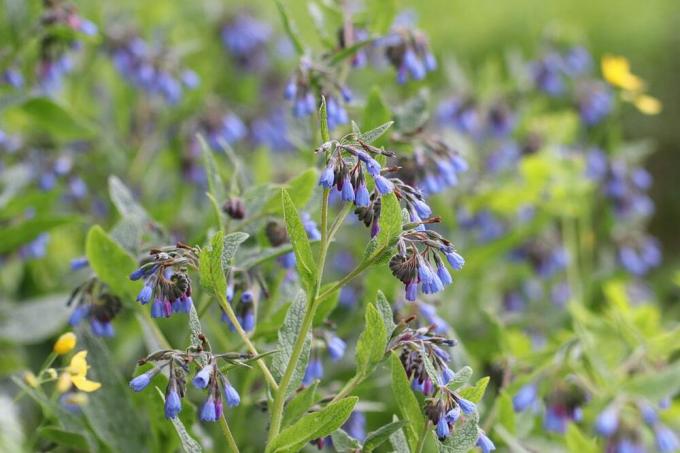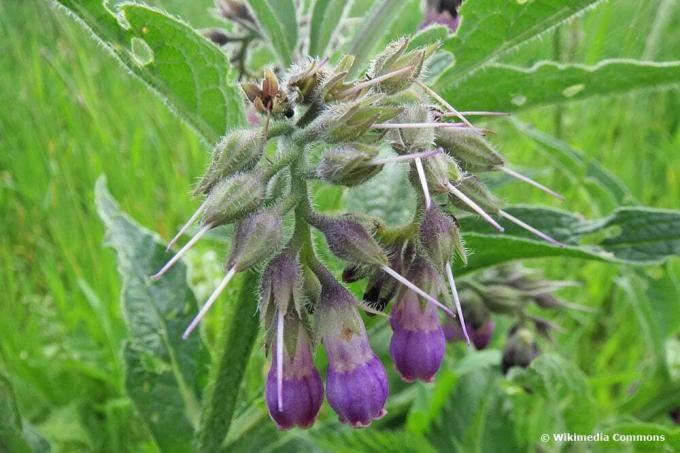
table of contents
- solar radiation
- PH value
- Nutrient richness
- Knit content
- humidity
- Space available
- Altitude
- Availability
- frequently asked Questions
Comfrey seeks its own place in the great outdoors. When settling in the garden, it is our task to find a suitable location. The following criteria make your search easier.
In a nutshell
- Sunny as well as partially shaded location suitable up to an altitude of 1000 m
- Provide nutrient-rich soil with enough nitrogen, the pH value between 6.5 and 7.5 is ideal
- A moist environment is preferred, but can also hold its own to some extent in dry places
- The comfrey site should be available for several years as the herb sprouts again in spring
- It takes up a lot of space: it grows up to 1 m high and spreads through runners
solar radiation
Symphytum officinale, as the wild herb is scientifically called, is not just a pretty plant. It is known and valued for its healing ingredients and as a natural fertilizer. So that it stores these substances in high concentrations in its parts of the plant, comfrey needs to get plenty of sun and warmth. So the comfrey location can be continuously sunny, for example a garden bed facing south. A partially shaded, protected location is also well tolerated as long as it is warm. Therefore, the plant can be used well as underplanting of bushes and trees. It shouldn't be too shady for him.

PH value
The ideal pH value for this weed is in the neutral range. The earth can also be weakly acidic or weakly alkaline. If you suspect the soil in the garden is different, a pH test should be performed. Since the pH value can fluctuate within the garden area, you should take a specific soil sample from the planned comfrey location.
- a value between 6.5 and 7.5 is ideal
- an unsuitable pH value does not mean the end
- Soil can be improved before planting
- by liming or adding acid-forming substances
Tip: Be careful not to plant the comfrey near conifers. Not only that the soil underneath is usually very acidic. Even after an increase in the pH value, it will not remain stable, as the decomposing needles allow the earth to slide back into the acidic area.
Nutrient richness
Comfrey needs plenty of nutrients. Medium to high humus content is ideal. If the soil at the future comfrey site is poor, it must be enriched with nutrients before planting. If the plant parts of this herb are used as a remedy or as a cooking ingredient, only natural fertilizers such as compost should be used.

Knit content
Many nutrients and trace elements are necessary for the healthy growth of this plant. But their need for nitrogen should be emphasized, because it is elementary and comparatively high. If there is a shortage, the depot can be filled with an organic fertilizer, for example with horn shavings or composted manure.
humidity
Comfrey prefers moist soils, which is why it also likes to grow on banks. Loamy, moist soil is also ideal in the garden. Then he develops an unbridled growth potential. However, the soil must also be loose and well-drained. If you don't have such soil in your garden and don't want to have a lot of work with the water supply, you can still try growing this herb. His adaptability and his strong urge to grow will keep him alive, although the growth will be more modest.

Space available
The comfrey location must offer enough space upwards and all around.
- The shoots of the comfrey can grow up to 1 m high
- the herb quickly conquers territory with its runners
Especially when underplanting bushes, the space must not be too tight. The neighbors should not be too close to each other. A planting distance of 1 m is a minimum. Otherwise you will have to constantly limit its spread or install a barrier.
Tip: If you want to cultivate comfrey in a pot, nothing speaks against it, as long as the location is right and the substrate remains moist. Make sure to use a deep pot when planting, however, as these weeds form a long taproot.
Altitude
This criterion is interesting for everyone who lives in a mountain region. For comfrey, the cultivation limit is 1,000 m. A location below this mark is always a good idea.

Availability
Each comfrey plant can sprout anew in spring for several years in a row. She does not want to experience a change of location during her entire lifetime. The comfrey location must therefore not be planned for any other purpose within this period of time.
frequently asked Questions
The herb is sufficiently hardy when planted to survive frost without further protective measures. However, the plant withdraws into its roots and sprouts again in spring. Pot specimens must leave their location before the first frost and overwinter in the house in a cool place.
Comfrey is currently not under protection. You can collect individual parts of the plant or the entire plant or plant. dig up a piece of root and move it to their garden.
The best time to plant out young comfrey plants are April and May. The best time for direct sowing is also the month of April.
The plant can sprout again and again from its root base for up to 20 years without having to change location. If you want to settle comfrey in another location, you can use a piece of its roots for propagation.

